Chapter 1
Coconut Oil

Get fragrant oil from a ripe coconut.
The coconut is one of the most incredible plants I’ve come to know. The tree itself is an engineering marvel. It consists of a skinny, serrated shaft that bends and sways with hurricane winds and then stands back up straight, up to four stories tall. The wood has long, stringy fibers running lengthwise that make it useful to fortify houses against a storm. Atop this graceful tendril, a bouquet of lush fronds branch out to form the skeleton of a sphere. These can be used for constructing roofs or walls and the leaves used to weave casings for rice dumplings and other artistic necessities. Nestled under this gorgeous tuft hang the fruits: heavy, round coconuts, full of sweet water and oil-rich meat. If you were designing paradise, you couldn’t do much better than this.
The coconut seed and the fruit are intermingled like I’ve never seen in another plant. Most fruits I know have a big old chunk of good sweet tissue for me to eat, and the complete seed or seeds are inside or scattered throughout. Here the entire entity is the seed. To get a new coconut tree, the densely fibrous husk outside must remain intact until germination occurs. Hack through 4 to 8 centimeters of the massive husk and you get to the hard shell.
If you’ve never been to the tropics, this shell may be all you’ve ever seen, because the husks are removed before coconuts are exported. Inside the shell, which is brittle and hard like teak wood, the centimeter-thick layer of rich white meat forms.1 Inside the hollow sphere created by the meat sloshes the magnificently fragrant and perfectly sweet coconut water.
This is not the milk; coconut milk has to be made from the meat, and we’ll do that in the process of extracting the oil. The water is some sort of glorious byproduct from the plant’s metabolism, and it will last in good shape for days after the coconut is harvested and stored. Throughout the tropics, young coconuts are sold on street corners for the water to be drunk and the smooth, young, partially formed meat to be scraped off and slurped down. Partaking of one on a sandy beach in Timor can lead you gently, inexorably to the idea that you really don’t need anything else in life at all; money, clothes, shelter, and other food and drink fade away to distant priorities in comparison to the blissful crystal of celestial perfection that you are currently imbibing.
I digress. Coconuts are one of the few local sources of oil for the Timorese, so they are highly sought after and the trees are well tended. At some point, it hit me that each of the thousands of coconut palms you see traveling around Timor was planted by someone and is owned by someone. Of course, they can reproduce naturally, but if that happens here, someone jumps on the sprout and claims it for his or her own.
To get the oil, you have to let the coconut grow to maturity, dry, and turn brown. You can either chop it off or let it fall on its own (watch your head—and your car!). Then the arduous process of extracting the oil from the meat begins. Let’s do it!
Gather stuff
- One or more whole ripe coconuts
- Water
- Sweet potato, if you have one
Gather tools
- Hammer
- Knife
- Chisel
- Grater
- Bowls
- Cloth strainer or clean rag
- Stove
- Wok or frying pan, nice and thick if possible
- Spoon
- Ladle
- Tongs
- Jars or glasses
Tinker
Your first task is to open this bugger. You can try slamming it onto concrete or hitting it with a hammer. You could saw it in half, but then it’s hard to get the meat out. If you can feel any water inside it, try to save and taste it; it’s often not bad, but not as good as young coconut water.

Now use the hammer and chisel to reduce it to smaller shards so it will be easier to get the meat out. But you don’t want the shards too small, because you’ll have to hold on to them as you grate them.

Now you have to separate the meat from the hard shell. This is a real trick. We used a knife and chisel. The Timorese often use a machete to hack away at the shell from the outside, but I figured you might not have a sharp machete—or know how to use it for this.2



Here the chief challenge is to avoid stabbing your hand. Be sure to stab and chisel away from any of your body parts. You want to work hard to separate the meat from the shell in large pieces, because if they’re too small, you won’t be able to grate them.
Once all the shell is separated from the meat, start grating. Use the finest section of the grater, the one where the bits don’t go through to the other side but fall off down the front. You want to grate it into the smallest pieces you can, to get at as much of the oil as you can. If you start grating your fingertips off, imagine if this were your sole means to attain cooking oil.


You don’t want to waste all those little bits you couldn’t hold on to anymore, so put them on the cutting board and mince them the best you can. Every cut is important to liberate more of that stubborn oil from inside the dreamy white meat.
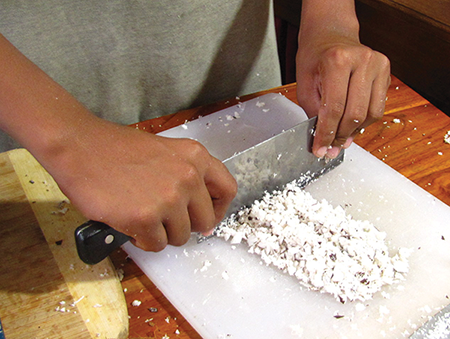
Halfway through the last time I did this I realized that our blender was sitting in the cabinet to my left. After a millisecond of hesitation, I hauled it out and did the rest with electric power. I can tell you that it still took a long time, because the blinking blender didn’t work with dry coconut, so I had to add the water—the next step in the process—which made it a mucky mess. You don’t really want it blended; what you need is a super-fine chopper. But I didn’t have such a fancy thing. The blender did end up beating a heck of a lot more oil out of my coconut meat than when we do it by hand. Of course, all this electrical stuff is cheating, but I guess it’s up to you in the end.
When it’s all grated, add a bit of hot water, then mush it all together. Every step in this process is designed to encourage the oil to emerge out of the pulp. The commercial professionals add just a tiny bit of water until it’s up to some exact wetness proven to be most effective at releasing the oil, and then squeeze it with massive hydraulic presses. It’s not easy to get such technology, so just know that every bit of water you add will have to be removed in the end. We added slightly over one cup of water for our average-sized coconut. Then we mushed it together for a while.
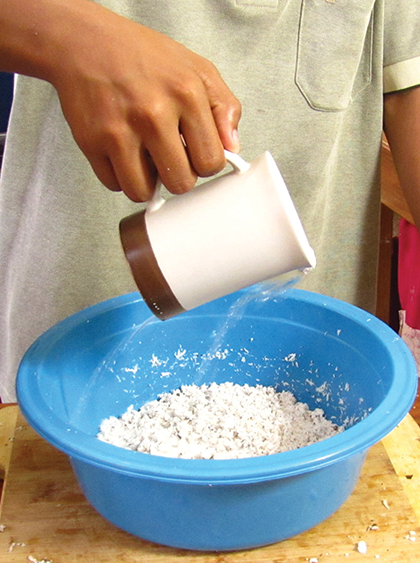

Now you need your cloth strainer. These are ever present here, because there are many things the Timorese use just the juice from. If you don’t have one, you can get a tight piece of cloth, maybe a handkerchief, or you might cut out the pocket of some discarded pants. Socks are the right shape, but their weave is a bit too loose (plus, think where they’ve been—eeww).
Get a bowl ready for the milk and then put a good heap of the coconut mush into the strainer held above the bowl.
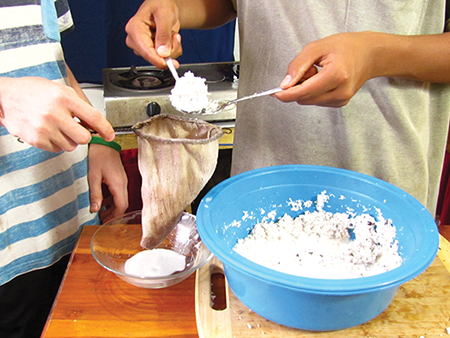
Now squeeze the bejeepers out of it. (Check out how they do this in the mountains, in the photo essay in the previous sidebar.) Every drop of liquid coming out of this will add a bit more oil to your final product, so do your best! We use the twist-and-squash technique.
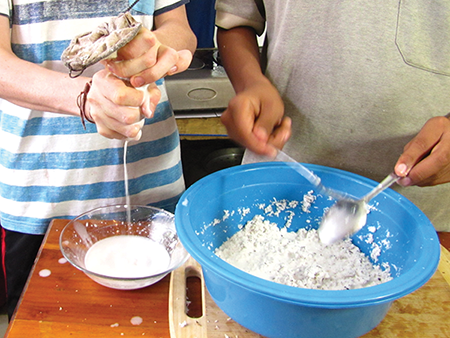
Dump out the dry remains when you’ve squeezed your best.
After a few rounds of straining and squeezing, there is your luscious coconut milk. And there are the forlorn gratings, dry and oil-less.
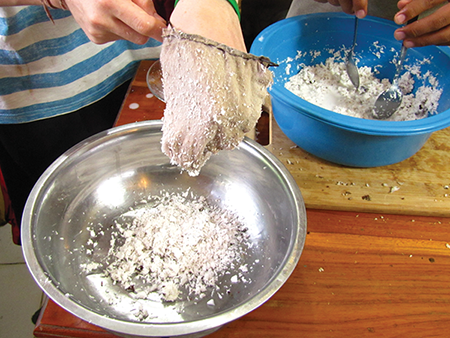

Or are they? There is an ongoing debate among my teacher colleagues about whether it’s worth it to splash a bit more water onto these, mix them up, and squeeze them again. It may release a few more drops of oil, but boiling the water off will then require more time and fuel. Let’s forget about it for now.
Here is where the paths part for virgin and non-virgin oil. You can try both, even with only one coconut. Divide your coconut milk into two parts: one part into a wok and one into a glass jar.
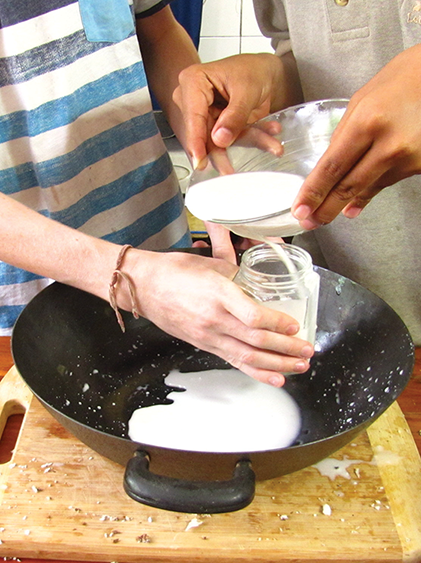
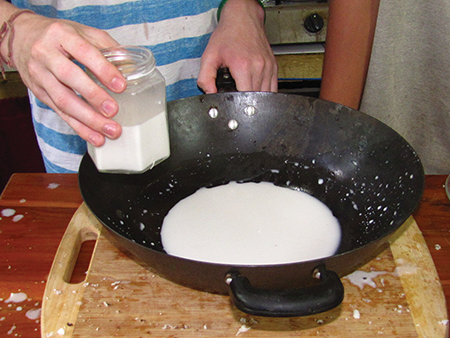
Place the glass jar on a shelf for a couple of days. That’s all there is to making virgin coconut oil: patience and then a bit of finesse in separating it out. It will start to separate immediately. The following photo shows the jar after 15 minutes.

For the process where you boil the milk—the process nearly everyone here uses—put the wok on a burner and set it to boiling on low heat.

Now get comfortable, because this takes a while. Basically, you’ve got to wait until all that water you put into the gratings boils away. The smooth milk will soon start to take on a curd texture. You can stir it if you don’t have anything better to do, but you don’t really need to. Just keep an eye out for the first little pools of oil to appear among the curds of coconut milk.
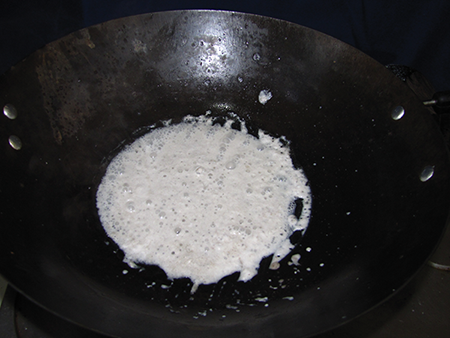

Here things begin smelling heavenly, something between a Malibu beach and a coconut macaroon. You begin to realize that there is some serious sugar in there as well as the oil, and when it caramelizes with the heat, a lovely scent is sent up.
When you finally see little pools of oil, you can try to grab them with the ladle or a spoon. Plop it in gently and try to get the oil to flow in over the side without getting any of the curd crud. Some people keep this early oil separate. It’s cleaner and clearer, and it will keep for longer than the cooked oil.
But you don’t have to do that, especially with the piddling amount of oil you get from an amateur job on a single coconut. You can go straight to the next step.
As soon as the majority of the curds look hard and crispy, take the wok off the fire. If you leave it on a couple of minutes too long, the oil and curds will burn and you’ll have ruined them, so don’t do that. Now all that’s left is to separate the oil from the crackly remains of the curds.

Wait a few minutes, because the next step is to work with the stuff that was just boiling. There is not much heat to dissipate, but be sure to wait at least 5 minutes until it cools down a bit.
Bring out your cloth strainer again. Wash it off well, and dry it too, the best you can. It’s not good to have water in your cooking oil. When you think the oil is at a workable temperature, put the strainer into a bowl and dump the contents of the wok into the strainer.

Pick up the strainer and squeeze it. For more force and to avoid getting too oily, we used tongs like a nutcracker, but maybe a nutcracker would work even better. You have to keep the strainer tightly closed and then squeeze it every which way as you watch the golden oil drip out into the bowl.
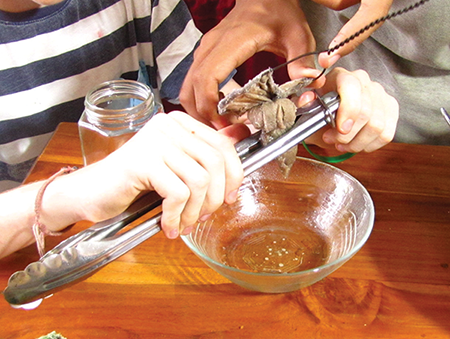
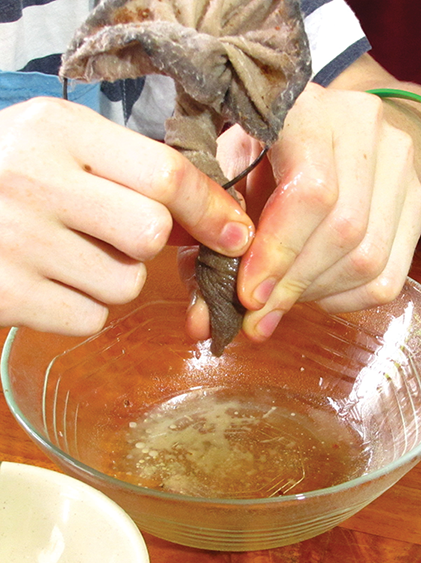
Again, no self-respecting coconut farmer will leave this part of the process until every last drop of oil is squozen from the candy in the strainer. Ah, yes, and it’s candy that’s left in the strainer when the squeezing is done. Have a bite.

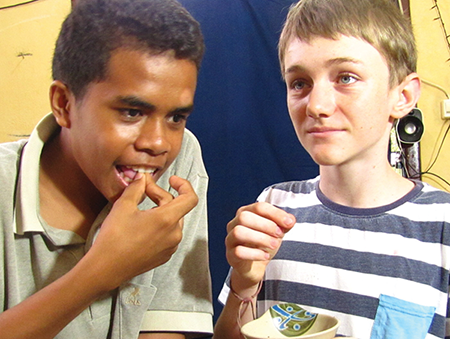
Rich? Like, the richest thing you’ve ever sunk your teeth into your whole life long? I find it so rich, sweet, and greasy that I can’t take more than one spoonful. I feel like I’ve eaten a super-concentrated donut.
Now pour your oil into a jar and smile. Here is the result of all that work. We got about half a cup. Wow.

The virgin oil will take a day or so to separate out.
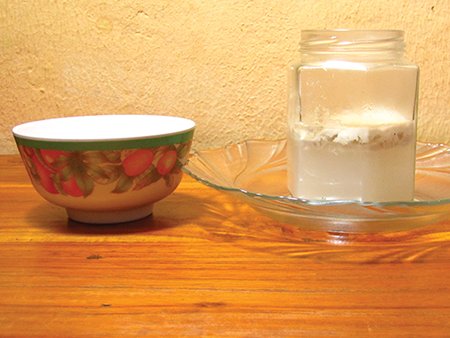
This gives you time to figure out how to get the oil away from the other stuff in there. We usually get a nice, milky water layer on the bottom, and the oil is still mixed with some curd-like stuff up top. The bad news is that if you dump the oil and the curds into a strainer, they both go through! Here is what we do: pour the oil and curd off the top, careful not to get any of the water from below, though inevitably some goes in. You can help it along with a spoon.

Now use the ladle or spoon method to selectively dip off the pure transparent virgin oil. Try to avoid all the water at the bottom.


When you’re down to the last bit, you can either put it in the pot and cook with it on the spot or try to pour it through the strainer again, or an even tighter cloth, like a cheesecloth, to try to separate the curds. Don’t squeeze it this time, because the curds come right through the cloth.3
And there you have it: virgin coconut oil.

Together with what you cooked up, that’s the sum total of all your efforts. Whatdya think? Worth it or not?
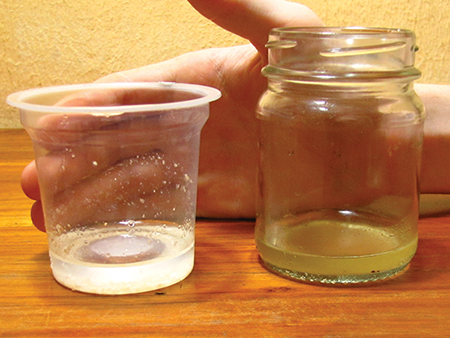
Wait, wait, first grab a sweet potato, slice it thin, and fry it up with one of these oils. Then reconsider: Worth it or not?
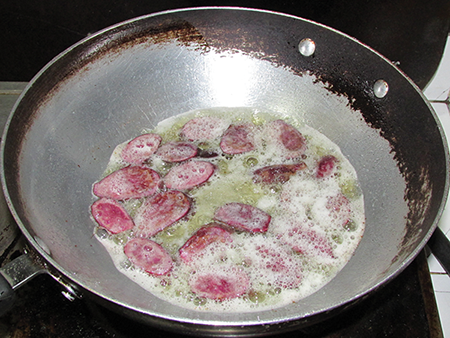
What’s Going On?
As with other oil-producing plants (sunflowers, soybeans, peanuts, etc.), the metabolism of the coconut results in an oily tissue, coconut meat. The plant uses this tissue to store away energy for use when it germinates and begins to grow into a new plant. And as in the case of all edible plants, we step in and take advantage of this clever little talent. None of the other plant sources of oil can give as much from a single fruit.
Who would have thought that those wondrous orbs hanging up under the coconut tree tuft would be able to produce oil? It must have been quite exciting to the original societies in prehistory who figured this out. In fact, research suggests that nearly all modern food crops have been modified by systematic management over generations of early farmers to result in higher yields of better nutrition than the original plant provided.
Here in the tropics, various critical crops come from trees. Aside from coconuts and palm kernel trees providing essential oil to the diet, jackfruit, breadfruit, bananas, and papaya are all used as either vegetables or starches, some becoming the main caloric intake during parts of the year when other local foods are not available. Then there is the sago palm, the very trunk of which can be eaten if you process it right. In temperate zones it seems to me that trees are less critical food-wise, sort of the dessert of the diet: fruits and nuts and maple syrup. It’s been great to learn so much about the way people make use of trees here in the tropics.
